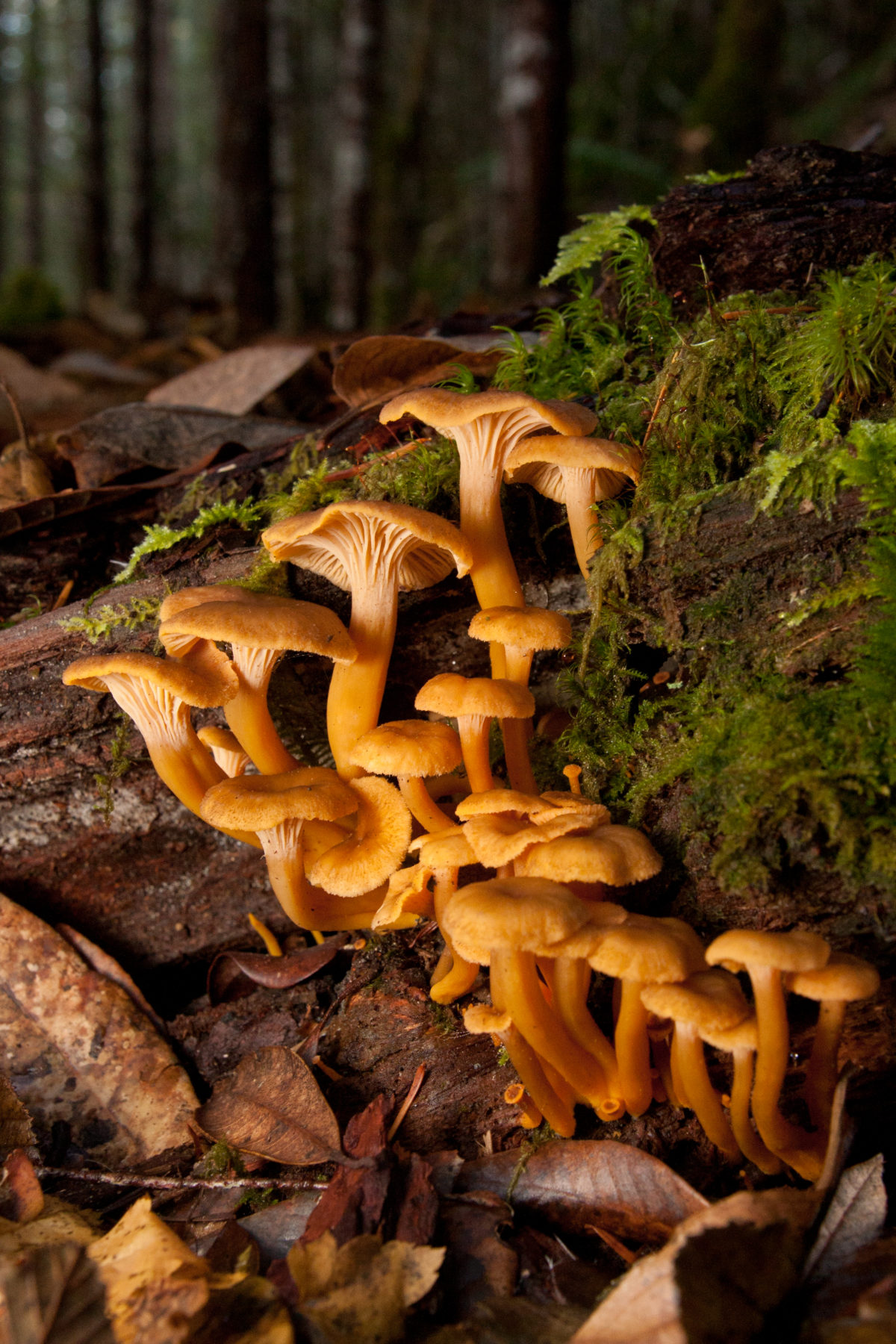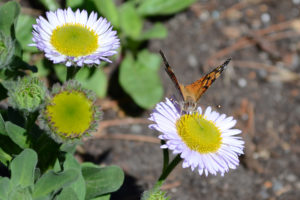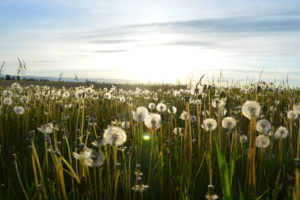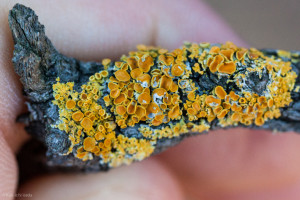midst the relict frontier homes and horse-drawn carriages of a Saturday afternoon in Woodside, it was easy to spot the ground-watchers I’d come to find. Heads down, baskets under their arms, they paced slowly across the hillside adjacent to the street, happily oblivious to the surrounding clatter of horse hoofs.
I parked at the side of the road and wandered up a hill just in time to catch Chris Schoenstein stepping down from a ladder leaned against the burl of an ancient oak, holding aloft an unusual prize: a lion’s mane mushroom (Hericium erinaceus), its bouncing white tentacles flowed over his hand. “What a primo beauty!” Schoenstein said.
Nearby foragers rushed into a huddle to examine the find. “It looks like an albino hedgehog!” said Schoenstein’s son. Mushroom hunters accustomed to common cap-and-stalk mushrooms passed the lion’s mane around, some gently combing the swaying tentacles against their cheek.
Served in French dishes under the alias pom pom du blanc, lion’s mane has a texture and taste resembling lobster or shrimp. Schoenstein, a lifelong enthusiast and member of the Mycological Society of San Francisco, has only seen one 2 or 3 times. But that, if you’re a mushroom hunter, is the hook that keeps you coming back to an event like the Wunderlich Foray, a daylong excursion into the Wunderlich Park in search of the rare, the unusual, and the mycological. For mushroom hunters in the Bay Area, the winter season after the fall rains is peak foraging time, and to find a good mushroom requires patience, practice, and a deep understanding of the natural world. Combine them successfully, like Schoenstein, and you get a prize to exhibit at the annual fungus fair in Golden Gate Park.
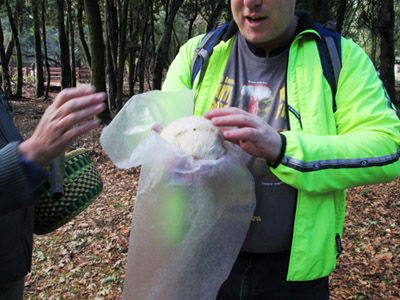
his year was Schoenstein’s fourth year leading the Wunderlich Foray. In good years – and the lack of rain means this year was not one of them—he says he has found 40 to 50 different species of mushrooms, with whimsical names such as hideous gomphidius, candy caps, pine spikes, and fat jacks.
The Wunderlich Foray was one of four early-December forays in San Mateo County to collect mushrooms for the MSSF Fungus Fair. The mushroom hunters walked the Wunderlich forest trails separately, heads down, fanned out like hunters beating the bush for rabbits. They probed the duff litter with walking sticks, flicking and overturning leaves to look for mushrumps, indicators of a protruding mushroom. For a long distance leaf flipping turned up only little brown mushrooms– nothing nearly as glorious as the lion’s mane. A rhythm descended on the mushroom hunt: the click of walking sticks, the crunch of leaves, and the disappointed sigh accompanying the identification of yet another cap-and-stalk button mushroom. But after about half an hour, Schoenstein called everyone to attention again: “Hey! You’ll like this, come look”!
Foragers scattered among the trail’s switchbacks or persistently searching the trail’s beginning now raced to find a shortcut up the steep slopes of the redwood-needle-covered mud. They regrouped and huddled around an old California bay tree, where Schoenstein stood with finger outstretched in the direction of an artist’s conk (Ganoderma applanatum) wedged in the bark, moisture dripping from the shaded underside.
The artist’s conk mushroom grows into a series of steps with concentric circles like ripples emanating from the heartwood. Schoenstein said he estimated the mushroom to be six years old, with each quarter inch ring equal to approximately a year of growth, like the growth rings of a tree. The hard mushroom is one of a few perennial mushrooms and Schoenstein urged us not to pick it.
Between the artist conk sighting and the lion’s mane, though, it had been pretty slim pickings. Baskets were empty. And while the fungus fair we’re collecting for is arranged to occur every year after the first rains of winter, when flushes of mushrooms appear overnight, Schoenstein said the big rain just before our walk had come too late for a good return.

own the road at Huddart Park, the hunting had also been slow, and a caravan of foragers that departed Wunderlich in hopes of finding wetter lands arrived at Huddart just in time to catch a review of the day’s finds.
Wade Leschyn, a past president of the MSSF, reached into the bed of his truck to unwrap a box, and carefully pulled out an olive-orange colored mushroom called the western jack-o’-lantern (Omphalotus olivascens). It’s a poisonous mushroom, though not usually fatal, with a superficial resemblance to a chanterelle, a cooking delicacy. Beginners have made the mistake, but it’s not too hard to tell them apart, Leschyn said, and he pulled a knife from his pocket and placed the blade between the gills of the mushroom. The blade’s tip disappeared between the orange gills, up to half a centimeter up the blade: proof, Leschyn said, that this mushroom was a western jack-o’-lantern. Chanterelles have shallow gills, reaching a millimeter depth at most, so a blade’s tip would have nowhere to hide.
Carelessness can have serious consequences, Leschyn said, and beginners should always take the time to study field guides and accompany experts on forays until they are comfortable with identification.
The early-December forays were open to the public, but only under Leschyn and Schoenstein’s collecting permits. Mushroom collecting is otherwise forbidden in most Bay Area parks and is only allowed, by permit, in demonstration forests such as Boggs Mountain or Soquel, and state parks such as Salt Point and Samuel P. Taylor.
When asked about the rules, Leschyn carefully placed the jack-o’-lantern back into his truck, closed the tailgate, and leaned against it with his arms crossed. While he said he understood that there’s potential for overharvesting, the regulations, he said, are preemptively causing greater harm. “The restriction reinforces the separation of our society from the natural environment,” he said. “We should use our environment and not have to act like trespassers on our public lands.”
While there’s a concern that foraging for mushrooms affects fungi populations, picking a mushroom isn’t necessarily a bad thing for the fungus. Mushrooms are actually only the tip of an iceberg, the fruits above a subterranean network of mycelium. Leschyn compared harvesting mushrooms to picking an apple off a tree. “You wouldn’t think twice about plucking the fruit,” he said, “or wonder whether the same tree would appear next season simply because you picked its falling fruits.”
ecause the body of the fungus lays invisible underground, where and when any given mushroom will appear is largely unpredictable. Scientists and hunters have yet to completely unravel the basic patterns of mushroom habits. But most follow seasons and prefer a particular tree, and once you’ve discovered a good patch, the same patch will likely return the next year.
This ephemeral quality, Leschyn said, reminds him of Brigadoon, a 1940s musical about a Scottish town that appears once every 100 years and disappears overnight. A fresh mushroom appears only for a few days after a rain, and if the devoted mushroom hunter fails to find it in the nick of time, the mushroom withers and returns to the ground as a rotting mush. In Brigadoon, the hero finds the town again only by demonstrating timely true love; in finding the most alluring mushrooms, timing is everything — and the outsider who wants to fill a pickup truck with fanciful mushrooms for the fungus fair must show true love for the craft.
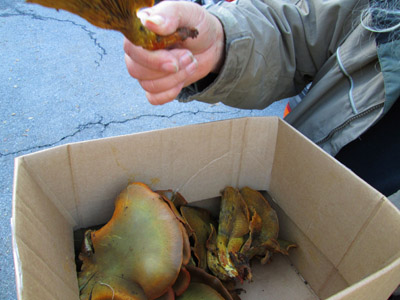
he fruits of that devotion went on display the day after the forays at the MSSF Annual Fungus Fair in Golden Gate Park. Nearly 200 species from all over Northern California were meticulously labeled and spread over pine-needle-covered tables, an earthly gallery of various shapes, colors, and smells.
At the mushroom displays, the same collectors from the previous day were standing behind a curious crowd, straining to quickly capture the history of a centuries old, worldly mushroom allure and their fascination with a strange, underground kingdom. Ethan Miller, a student in Tom Bruns’s mushroom identification class at UC Berkeley, said he finds himself attracted to the optical illusions inherent in finding little mushrooms. “Walking down Sunset Drive in the fog belt of San Francisco, I find myself side-eyeing every pile of woodchips,” Miller said, “but once I get on my hands and knees, mushrooms start popping out and I head in the right direction.”
Part of the allure is also in the wide use of mushrooms. They don’t just serve as food; the Bay Area Radical Mycology group uses fungi to restore degraded habitats, a practice known as mycorestoration, by using a living fungus to filter fecal bacteria of cattle from drinking water, and spores to inoculate fallen trees to speed decomposition and limit fire fuel load.
The California Native Plant Society uses the same toxic chemicals that cause inedibility in lichens and mushrooms to dye fabrics including wool, silk, and cotton by placing the poisonous lichen or mushroom in simmering water. The jack-o’-lantern, the common bane of the amateur, can color wool and silk a deep purple without risk of poisoning.
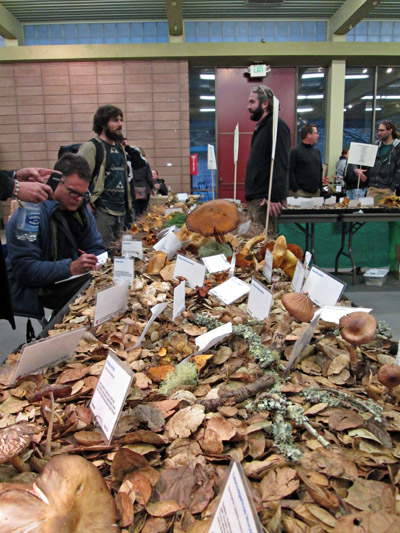
t wasn’t a great weekend for mushroom foraging. But foraging, fortunately, isn’t the only way to get your mushroom fix. As I left the Fungus Fair at the end of the day, I found a $5 donation station that offered “inoculated mushroom bags” of “mother spawn”: mycelium, grown from spores and barley, that lets you grown your own edible mushrooms at home. Once the oyster, shiitake and matsutake mushrooms start, you can even tear off a piece of the original mother spawn and share it – a practice more reliable, if less active, than hunting in the park.
For perspective on the underground world of mushroom foraging, take MSSF member Steve Warner’s advice and “follow the water” to find the mushrooms, or attend his docent-led mushroom walk on January 5. There are a variety of other ways the Bay Area resident can get involved with mushrooms: find a local viewing or collecting spot, with one of the local guides described as a “mushroom hunter’s bible” (I recommend All That the Rain Promises, and More, for its hilarious stories) and cook with MSSF’s mushroom cookbook. Also visit Santa Cruz’s 40th annual fungus fair January 10-12 or join one of the many organizations listed above for ongoing forays, potluck dinners, and restoration work.

